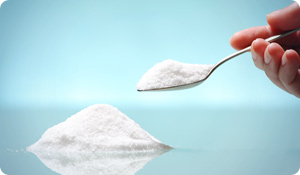
Salt is made up of sodium and chloride. Both are essential nutrients needed by the body. Sodium maintains the body's fluid balance, helps with nerve impulse transmissions and muscle contractions. The adequate intake for sodium is 1500 milligrams for adults 19-50 years old and 1300 milligrams for adults 51-70 years old.
But Americans consume way more than that. And this can be a problem for a couple of reasons. First, a high sodium intake may cause high blood pressure. High blood pressure increases the risk for developing heart disease, stroke, congestive heart failure, and kidney disease. Research shows that eating less than 2,300 milligrams of sodium, which is about one teaspoon of salt, may reduce the risk of high blood pressure. The average sodium intake of most Americans exceeds 4,000 milligrams per day. That's why one of the 2005 Dietary Guidelines for Americans is to reduce sodium intake.
A high sodium intake has also been linked with an increased risk for osteoporosis, making bones more susceptible to breaking. This is because a high sodium intake may cause the body to lose calcium. More research is needed in this area.
Most foods are low in sodium in their natural state. But processing increasing sodium content, therefore, most processed foods are high in sodium. The Nutrition Facts Label contains the amount of sodium in one serving of the food.
Some terms on the Nutrition Facts Label that are helpful include:
- Sodium Free - a product that contains 5 milligrams or less of sodium per serving
- Very Low Sodium - a product that contains 35milligrams or less of sodium per serving
- Low Sodium - a product that contains 140 milligrams or less of sodium per serving
- Light in Sodium - a product contains no more than 50%of the sodium of the comparison food.
Some high sodium foods include:
- Canned vegetables
- Canned soups and boullion
- Snack foods such as pretzels and chips
- Cured meats such as ham and bacon
- Pickled foods
- Packaged mixes
- Frozen dinners
- Soy sauce
- Chinese food
- Restaurant foods
Some tips to cut your salt intake include:
- Cook with little or no added salt.
- Use herbs and spices to season foods such as garlic, ginger, lemon juice, basil, etc.
- Try to add little or no salt at the table. Always taste your food before adding salt.
- Read food labels and choose foods that are low in sodium, no added salt or sodium free.
It's important to note that the taste for salty grows on you so that the more you eat, the more you want. Conversely, the less you eat, the less you desire. So, even though you may be used to eating food that is high in sodium, it is possible to adjust to enjoying foods with less salt.
Sources:
- Understanding Nutrition, Tenth Edition by Eleanor Noss Whitney and Sharon Rady Rolfes, Wadsworth Group, 2005
- www.eatright.org - website of the American Dietetic Association - Nutrition Fact Sheet on Salt





